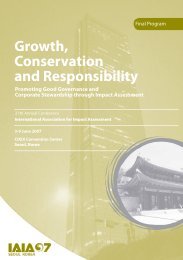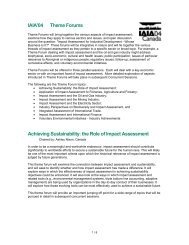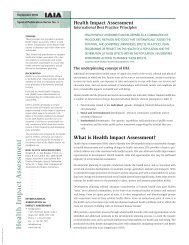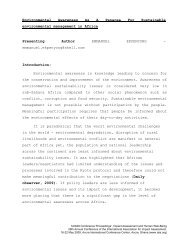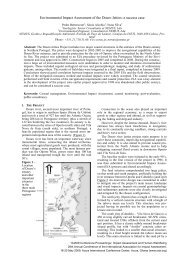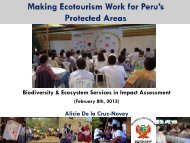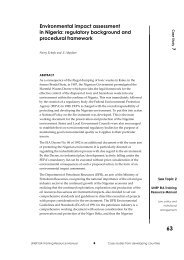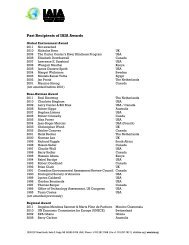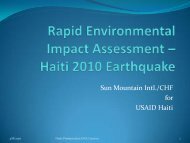Power, poverty and sustainability - International Association for ...
Power, poverty and sustainability - International Association for ...
Power, poverty and sustainability - International Association for ...
You also want an ePaper? Increase the reach of your titles
YUMPU automatically turns print PDFs into web optimized ePapers that Google loves.
• IAIA06 Abstracts Volume •<br />
• Improved Russian –Norwegian cooperation<br />
The EIA as Part of <strong>International</strong> Trade Agreements–<br />
Example: North American Free Trade Agreement<br />
(NAFTA) Operations?<br />
Podhora, Aranka; Berlin University of Technology, Straße des<br />
17. Juni 145, Sek. EB 5, Berlin, 10623 Germany. 0049 - 30 -<br />
314 734 93. podhora@ile.tu-berlin.de<br />
Köppel, Johann; Berlin University of Technology, Straße des<br />
17. Juni 145, Sek. EB 5, Berlin, 10623 Germany. 0049 - 30 -<br />
314 22 34 4. koeppel@ile.tu-berlin.de<br />
As the first transnational trade agreement the North American<br />
Free Trade Agreement (NAFTA) is amended by an<br />
environmental treaty. It is signed by NAFTA’s three members:<br />
Canada, the United States <strong>and</strong> Mexico. The Commission on<br />
Environmental Cooperation promotes its goals <strong>and</strong> controls its<br />
defaults.<br />
An important role plays the environmental protection in a<br />
transboundary context <strong>and</strong> with it the EIA. Canada, the United<br />
States <strong>and</strong> Mexico have national requirements to the EIA. But<br />
because of the differences in legislation, administration <strong>and</strong><br />
appliance, the three countries need to find solutions <strong>for</strong> a<br />
transboundary cooperation. As dem<strong>and</strong>ed in the agreement<br />
the Commission shall establish recommendations <strong>for</strong> the<br />
border areas concerning the<br />
• Assessment <strong>and</strong> evaluation of environmental impacts<br />
of certain projects.<br />
• Mitigation of the environmental impacts.<br />
• Cooperation between the affected countries.<br />
A strong environmental agreement <strong>and</strong> with it a strong EIA<br />
could be an important step towards the integration of<br />
environmental aspects into world trade. It gains importance<br />
especially in terms of NAFTA’s possible enlargement including<br />
all Latin American countries.<br />
The paper is based on a current Ph.D. thesis at the Berlin<br />
University of Technology. It discusses possible solutions to the<br />
problem (e.g., twinning <strong>for</strong> projects, empowerment of<br />
institutions).<br />
Phase 1B of the Lesotho Highl<strong>and</strong>s Water Project: A<br />
Transboundary Impact Assessment Case Study<br />
Willemse, Nico E; Southern African Institute <strong>for</strong><br />
Environmental Assessment, Robert Mugabe ave.,<br />
Ausspanplatz, Windhoek, Namibia. ++ (0)61 284 2726.<br />
versacon@iway.na<br />
The LHWP was developed to curb the projected increase in<br />
water dem<strong>and</strong> in South Africa’s Gauteng Province while<br />
making water Lesotho’s only export commodity. The project<br />
promised to benefit grassroots people <strong>and</strong> boost economic<br />
development but instead was publicized <strong>for</strong> severe social<br />
harm, corruption <strong>and</strong> negative impacts on the environment. A<br />
full EIA was done that recognized transboundary impacts but<br />
did not consider such impacts in detail. An Instream Flow<br />
Requirement (IFR) study was done after Phase 1B of the<br />
LHWP had commenced, <strong>and</strong> the altered flow of the Senqu-<br />
Orange River has negative impacts on the middle <strong>and</strong> lower<br />
Orange River <strong>and</strong> its riparian states:<br />
• Transboundary impact on the environment <strong>and</strong> its<br />
users<br />
• Biodiversity threats<br />
• Promotion of water borne diseases<br />
• Eeffects of changes in geomorphology <strong>and</strong> hydrology<br />
of the river<br />
• Aggravating water scarcity in the region<br />
• Orange River Mouth Ramsar site<br />
• Lessons learned<br />
• The role of political power in transboundary<br />
development projects<br />
• Negative effects of hurried project<br />
implementation<br />
• The need <strong>for</strong> broader consultation during<br />
development<br />
• Failure to adequately acknowledge<br />
transboundary impacts<br />
• Negative effects<br />
CS 18.1 THE MARRAKECH ACTION<br />
PLAN AND FOLLOW-UP<br />
Building Awareness of IA Capacity Building<br />
Among Decision Makers<br />
Mercier, Jean-Roger; World Bank, 1818 H Street NW,<br />
Room MC5-139, Washington, DC 20036 France. +1-202-<br />
473-5565. jmercier@worldbank.org<br />
Leonard, Peter; Hydro Québec, 75 Blvd René Lévesque<br />
Ouest, 10th FLoor, Montréal, PQ H4A 3M7 Canada. 1<br />
514 289 2211 ext:4282. leonard.peter@hydro.qc.ca<br />
Ramasar, Vasna; Private, 464 Frere Road, Glenwood,<br />
Durban, KwaZulu-Natal 4001 South Africa. 083 564<br />
4841. v.ramasar@gmail.com<br />
A four-pager has been prepared in draft version. Its<br />
objective is to in<strong>for</strong>m decision makers about the benefits<br />
of capacity building <strong>for</strong> Impact Assessment as a key tool<br />
to enhance governance at regional, national, subnational<br />
<strong>and</strong>/or local levels. The draft will be presented<br />
<strong>and</strong> finalized with the participants in this very<br />
interactive session.<br />
Identifying <strong>and</strong> Adopting Effective Approaches<br />
<strong>for</strong> Capacity Building<br />
Abaza, Hussein; UNEP Economics & Trade Unit, 11-13<br />
Chemin des Anemones, Geneva, Chatelaine 1219<br />
Switzerl<strong>and</strong>. +41 22 917 8178. Fax +41 22 917 8075.<br />
hussein.abaza@unep.ch<br />
In order to enhance national <strong>and</strong> intitutional<br />
environmental assessmentt capacity building, it is<br />
essential to identify <strong>and</strong> adopt effective approaches <strong>for</strong><br />
capacity building. The development of such programmes<br />
should initially be based on a needs assessment<br />
conducted by national experts <strong>and</strong> institutions. Such a<br />
needs assessment should include the identification of<br />
target groups <strong>for</strong> capacity building, including policy <strong>and</strong><br />
decision makers, <strong>and</strong> government practitioners, as well<br />
as practitioners in national research institutions, the<br />
private sector, non-governmental organizations,<br />
industry, <strong>and</strong> financial institutions. It should have a<br />
long-term perspective <strong>and</strong> go beyond the traditional<br />
approach of <strong>for</strong>mal training courses. The capacity<br />
building programmes need to be geared to address the<br />
development priorities of countries, including how the<br />
enhanced capacity in this area will assist countries<br />
develop sustainable development policies, sustainable<br />
trade, <strong>and</strong> <strong>poverty</strong> reduction. National institutions <strong>and</strong><br />
experts should take the lead in implementing capacity<br />
building activities <strong>and</strong> programmes. Based on past<br />
experience <strong>and</strong> lessons learned, compiling a reference<br />
document on best practices <strong>for</strong> effective capacity<br />
building should be a useful tool <strong>for</strong> trainers to design<br />
82


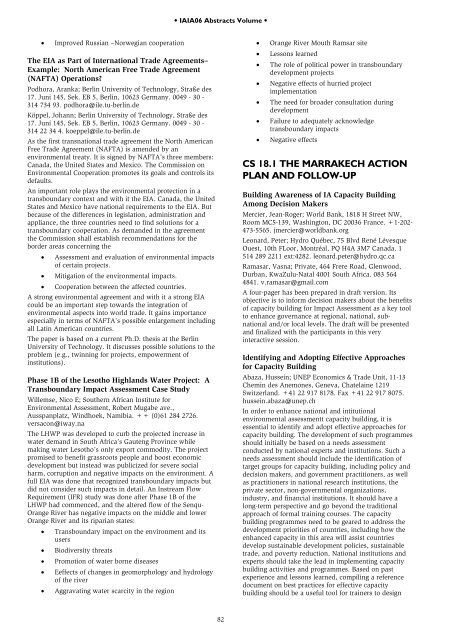

![Session Report [PDF] - International Association for Impact Assessment](https://img.yumpu.com/22416146/1/190x245/session-report-pdf-international-association-for-impact-assessment.jpg?quality=85)
![Session Report [PDF] - International Association for Impact Assessment](https://img.yumpu.com/22416140/1/184x260/session-report-pdf-international-association-for-impact-assessment.jpg?quality=85)
